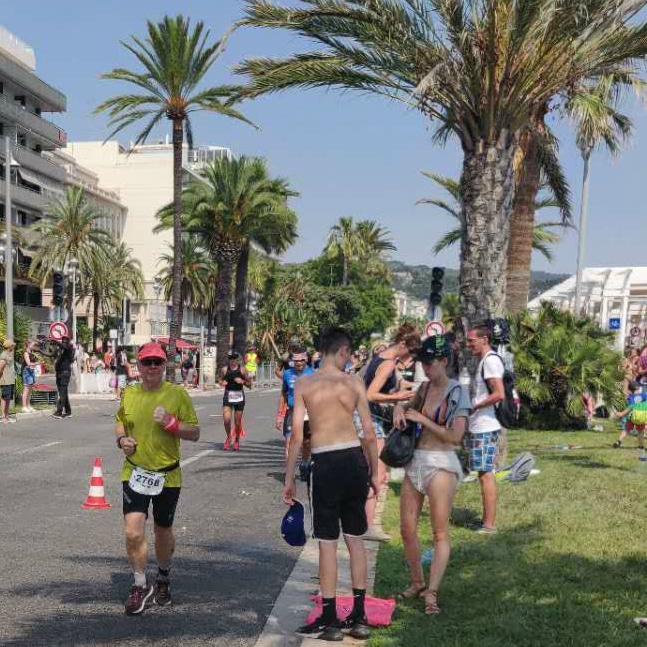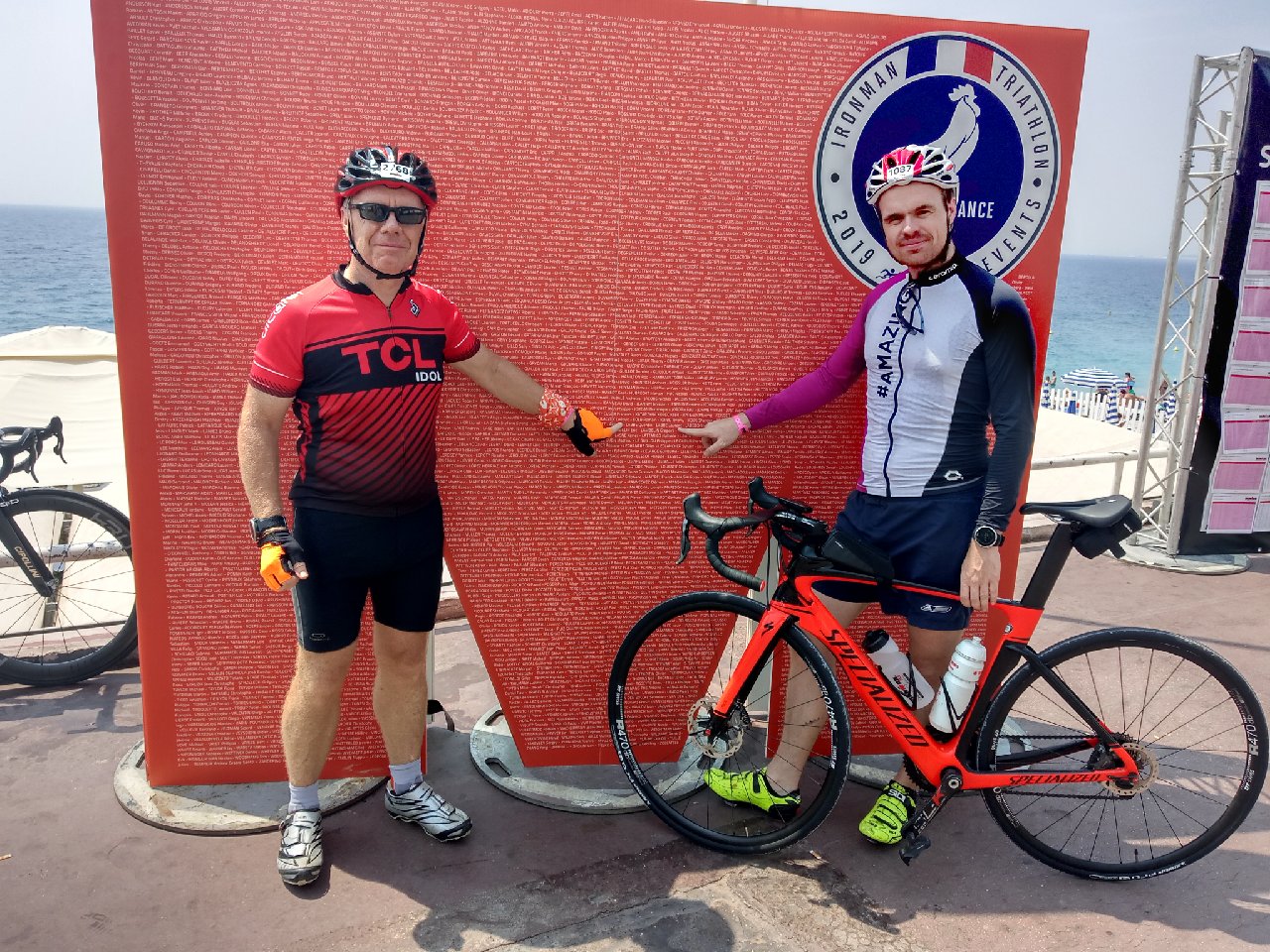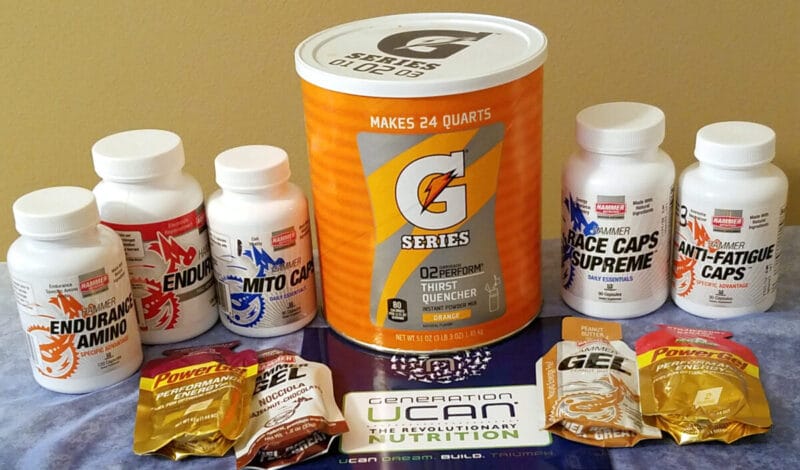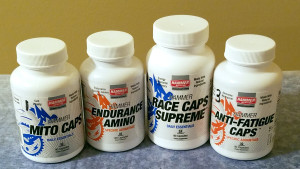Lessons in Ironman Triathlon Racing – Another Senior Triathlete’s Experience
Laurent Labbe recently finished Ironman Nice, a long course triathlon that boasts swimming in the Mediterranean Sea, biking in the Alps, and running along the French Riviera in Nice’s historic waterfront. While the beautiful venue made the race enjoyable, Nice was even more special for Laurent. It confirmed an Ironman triathlon hydration and nutrition plan he had been working to develop.
Disappointment at Ironman Vietnam
Before diving into the story from Nice, let’s go back a little less than two months to Vietnam. It was here that Laurent competed in Ironman 70.3 Vietnam, his 10th long course triathlon.
Following a disappointing race at Ironman Vietnam, Laurent determined to come up with a better approach to nutrition and hydration for an ironman triathlon. Regarding Ironman Vietnam, Laurent said:
“The bike part was a little bit slower than I had planned, but the running was the worst leg. It was very hot. The temperature at the start of the swim was 29⁰C (84⁰F) and 35⁰C (95⁰F) during the run. I didn’t manage it well. I was overheated and the only way I found to complete the run was to put water on me every 2 km (1.25 mile) to cool down.”
Laurent had anticipated the heat. He had prepared an adequate amount of water to carry on the bike. He also carried a cereal-based energy bar to eat about halfway through the bike course.
However, he had not included any sports drink with electrolytes. This was his first mistake. He also forgot to eat the cereal bar during the bike leg until much later than planned.
The consequence of not consuming a sports drink with its electrolytes on the bike became especially evident when he got to the run. While his body craved the electrolytes, he found the sports drinks provided by the race organizers to be “disgusting”.
And, when he tried to make up for not eating early enough on the bike by consuming bananas and gels during the run, his stomach revolted.
An Incentive for a New Ironman Triathlon Hydration and Nutrition Plan
Laurent is not alone in forgetting to eat on the bike during an Ironman triathlon. I have lost count of the number of stories of triathletes who were so caught up in the excitement of a race that they forgot to eat or drink until it was too late. As a result, they “bonked” or at least hurt their performance on the run. Maybe it’s happened to you.
With this not-so-pleasant experience in Vietnam, Laurent was determined to finding a better approach to hydration and nutrition for his next race in Nice, France. The challenge was that he had less than two months.
Hydration and Nutrition Plan for Ironman Nice
With the memory of Vietnam fresh in his mind, Laurent stayed focused on developing his race plan for Ironman Nice. He reflected on his experience in training and racing, spoke with other triathletes, scoured the internet, and tested various nutrition and hydration products.
In looking back on the Nice triathlon, he was able to say with a smile, “It seems that all the preparation and, this time, the race management was right”.
So, what was the race plan that made such a big difference?
Let’s start by looking in on Laurent a few days before the Nice triathlon while he was putting the final touches on his plan.
A Pre-Race Test of the Plan
During the week before the race, Laurent rented a bike and he and his son road to the top of Le Mont Ventoux, one of the most famous portions of the Tour de France.
He used this ride to test a bike computer having a screen large enough for him to continuously monitor his heart rate and to watch the time so that he would eat and drink at precise intervals.
It became clear to Laurent during this ride that without a clock his perception of time was wildly inaccurate. However, by maintaining a heart rate within the aerobic zone and drinking a little every 10 minutes, Laurent was able to ride the 40 km (25 km) distance to its 1,909 m (6,260 ft) elevation without stopping.
Laurent felt prepared for Nice.

Racing Ironman Nice
The temperature on race day in Nice was also high, 27⁰C (80⁰F) at the start of the swim. The day’s high of 34⁰C (93⁰F) occurred during the bike leg. Anticipating these temperatures, race organizers reduced the distance of the race a bit to 150 km (93 miles) for the bike and 30 km (18.6 miles) for the run.
Racing with a Heart Rate Monitor
Laurent used the heart rate monitor to control his effort on both the bike and run to maintain a heart rate within the endurance range.
For the bike leg, this meant maintaining an average rate of 144 beats per minute (bpm); his heart rate never went above 161 bpm. “I could have probably gone faster (on the bike) without any problem. However, the target for this race was to finish within the time limit.”
For the run, Laurent’s target was an average heart rate of 139 bpm, his endurance training rate. The highest rate came in the last 500 m during his sprint to the finish line.
“I saw many people on the bike and run forcing themselves and having difficulty breathing. In contrast, I was able to ride and carry on conversations with other racers including a Chinese guy, a Moroccan lady, and a man from Dubai.
Hydration and Nutrition for Ironman Nice Triathlon
Laurent’s nutrition and hydration plan reflected his experience in previous hot weather Ironman races and with the week earlier ride to the summit of Le Mont Ventoux.
Specifically, the plan was as follows.
- On each of the three days leading up to the triathlon, he took a serving of Overstim Malto. Admittedly, this was based solely on the recommendation of a friend and not on any personal experience.
- On the bike:
- Alternated drinking from one of the two bottles of sports drink, one bottle each of Overstim Long Distance Hydrixir and Hammer Nutrition Sustained Energy, every 10 minutes throughout the bike leg. Laurent also carried extra packages of the powders. These would be used to refill the bottles if he happened to run out before the end of the bike leg.
- Ate one packet of a fruit-based energy gel, such as those from Overstim, every hour. Since the gels come either with or without added salt, he took one of the salted versions at the mid-point and near the end of the bike.
- Stopped eating any solid food around one hour before the end of the bike. This provided time for the food consumed during the bike to be digested before beginning the run. Running with undigested food can cause stomach problems.
- On the run:
- Drank some water with a little added salt provided by race organizers at each aid station.
- Ate a salted biscuit or a salted gel at each of the aid stations.
- Used showers provided by race organizers to help cool down.
- On the day after the race, he took a recovery drink; Hammer Nutrition Recoverite is an example.

Will This Plan Work Next Time?
Laurent completed the race feeling strong, healthy, and with little to no pain during and after the race. Racing with a heart rate monitor, staying hydrated, and consuming calories at the right times appeared to be the key.
Laurent found this approach to be effective, at least for one long bike ride and one long course triathlon. However, he is quick to acknowledge that he has no training in sports medicine or nutrition.
It will be interesting to hear what happens when he uses this approach in the next triathlon.
Please Share Your Questions and Comments
What do you think about Laurent’s racing plan?
Have questions about hydration and nutrition for ironman triathlon?
What are the most important lessons you have learned from training and competing in a triathlon?
Share your thoughts and questions in the Comments section below.



